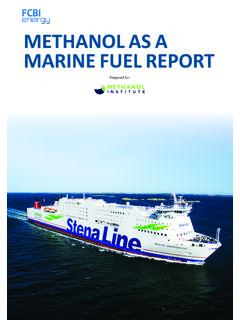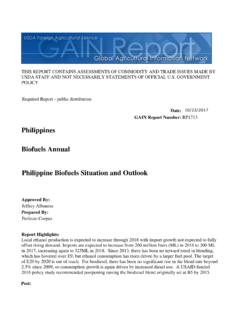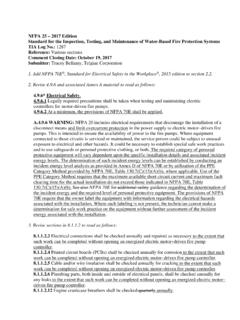Transcription of BECCS requires the wide-scale deployment of CCS from ...
1 1 2 BECCS requires the wide-scale deployment of CCS Historically BECCS deployment has been slow; there are few operating facilities Major BECCS technologies are mature; their potential is substantial The availability of land, water and fertiliser to supply biomass is the major constraint on BECCS Most climate change scenarios use negative emissions technologies to draw CO2 from the atmosphere; of these, BECCS is the best option The scale of BECCS deployment reaches gigatonnes of CO2 stored per year to meet global warming targets set for the end of the century 3 After almost thirty years of climate change negotiations, global CO2 levels are still rising (NOAA, 2018). The UNFCCC Paris Agreement goals of holding global warming to well-below 2 C and to pursue efforts to limit it to C are in stark contrast to the ever-dwindling carbon budget.
2 The evidence makes it clear. CO2 needs to be removed from the atmosphere, known as carbon dioxide removal (CDR)1, using negative emissions technologies (NETs) to meet global warming targets. Bioenergy with carbon capture and storage ( BECCS ) is emerging as the best solution to decarbonise emission-intensive industries and sectors and enable negative emissions (Figure 1). BECCS is part of the broader CCS technology group. Bioenergy has been used since the dawn of time by humans to produce heat. Today, bioenergy is used to fuel vehicles through bioethanol and provide electricity by burning biomass. CCS has been working safely and effectively since 1972 to capture CO2 from a wide range of industries and sectors. Today, there are 18 large-scale facilities in operation, five under construction and 20 in various stages of development.
3 CCS is becoming the conduit for a new energy economy and enabling the decarbonisation of industry including BECCS . Figure 1: Bioenergy and carbon capture and storage ( BECCS ) schematic 1 CDR technologies include afforestation, reforestation, ocean fertilisation, DACS, and BECCS 4 BECCS involves the utilisation of biomass as an energy source and the capture and permanent storage of CO2 produced during the conversion of biomass to energy. There is no singular definition of BECCS since it can include a variety of industries, biomass feedstocks and methods of energy conversion. The final use of the biomass also varies widely. What is clear is that CCS is integral to the process, which includes: 1. Biomass feedstock draws down CO2 from the atmosphere through photosynthesis as the plants grow.
4 Biomass feedstock is derived from a residual product ( sugar cane waste) or dedicated energy crops ( fast-growing tree species like willows trees) planted purely as a feedstock Today biomass feedstock supply is dominated by forest management schemes and agriculture Algae cultivation and municipal organic solid waste is being tested 2. Biomass is then transported to the end-user or a conversion facility. 3. Biomass is combusted or is converted to biofuel using digestion/ fermentation processes. CO2 is produced during combustion or conversion. 4. CO2 is then captured and stored. 5. Negative emissions are possible if the CO2 stored is greater than the CO2 emitted during biomass production, transport, conversation and utilisation. BECCS is applied in two overarching methods according to the utilisation of the biomass combustion and conversion.
5 Combustion directly uses biomass as a fuel source to produce heat for use in electricity generation or industrial applications including cement, pulp and paper making, waste incineration, steel and iron, and petrochemical to highlight a few. The CO2 is captured from the flue gas stream produced during combustion. The second method involves the conversion of biomass through either digestion or fermentation to produce gaseous or liquid fuels, respectively. The most common fuel is bioethanol which produces a near-pure stream of CO2 during the fermentation process. The CO2 is then compressed and stored, omitting the need for capture. The subsequent combustion of the biofuel or gas also produces CO2 which, if not stored, results in overall lower emissions reduction.
6 Currently, five facilities around the world are actively using BECCS technologies (Figure 2; Appendix 1). Collectively, these facilities are capturing approximately million tonnes per year (Mtpa) of CO2. 5 The only large-scale2 BECCS facility is the Illinois Industrial CCS facility that captures up to 1 Mtpa of CO2. Owned by Archer Daniels Midland, this facility produces ethanol from corn at its Decatur plant, producing CO2 as part of the fermentation process. The CO2 is stored in a dedicated geological storage site deep underneath the facility. The remaining four BECCS facilities operating today are small-scale ethanol production plants, using most of the CO2 for enhanced oil recovery (EOR); including: 1. Kansas Arkalon (USA): 200,000 tpa of CO2 is compressed and piped from an ethanol plant in Kansas to Booker and Farnsworth Oil Units in Texas for EOR.
7 2. Bonanza CCS (USA): 100,000 tpa of CO2 is compressed and piped from an ethanol plant in Kansas to nearby Stewart Oil field for EOR. 3. Husky Energy CO2 Injection (Canada): 250 tonnes per day (tpd) of CO2 is compressed and trucked from an ethanol plant in Saskatchewan to nearby Lashburn and Tangleflags oil fields for EOR; the fields are shallow (~500m) and comprise heavy oil. 4. Farnsworth (USA): Over 600,000 tonnes of CO2 was compressed from an ethanol plant (Kansas) and fertiliser plant (Texas) and piped to Farnsworth oil field for EOR. Injection has now ceased as part of DOE/NETL SouthWest Partnerships Development Phase but currently monitoring the injected CO2 at an ongoing EOR operation. Three additional projects are planning on BECCS : 1. Mikawa Power Plant (Japan): The retrofit of a 49-megawatt unit power plant in Omuta (Fukuoka Prefecture) to accept 100 per cent biomass with a CO2 capture facility.
8 The focus is now identifying a secure offshore storage site. 2. Drax Power Plant (UK): Biomass power generation pilot in North Yorkshire with the potential to develop CO2 capture and storage 3. Norwegian Full-Chain CCS (Norway): BECCS integration into waste-to-energy and a cement plants: Klemetsrud waste-to-energy plant: Plans to capture 400,000 tpa of CO2. Norcem Cement plant: Currently co-fires up to 30 per cent biomass and plans to capture up to 400,000 tpa of CO2. Both plants will send their CO2 to a multi-user storage site in the Norwegian North Sea. Several notable bioenergy facilities utilise the CO2 for crop cultivation (greenhouses). (See Appendix 1 for details). 2 The Global CCS Institute definition of large-scale is capturing and storing greater than 400,000 tpa CO2 for industrial facilities; 800,000 tpa CO2 for power generation.
9 6 Figure 2. Bioenergy and carbon capture and storage facilities worldwide (Global CCS Institute, 2019) 7 The individual technologies to utilise biomass to produce energy or fuel, as well as the capture, transport and storage of CO2, are all mature and active in commercial facilities around the world (Table 1). There is enormous potential for BECCS . The largest (in terms of energy production) and most commercially-attractive BECCS application is the production of bioethanol and CCS. The technology is already mature. In 2017, around 68 Mtoe3 of biomass-derived biofuels were produced; two-thirds were ethanol (IEA, 2018). The USA produces over half of the world s biofuels, but there are opportunities around the world, including developing nations across South America, Sub-Saharan Africa and South East Asia.
10 An increase in biofuel use in the transport sector could initiate a reduction in CO2 emissions in a traditionally difficult sector to decarbonise. For global power generation, biomass supplies about 52 Gigawatts (GW) (CSLF, 2018). Just those 52 GW today could result in significant CO2 reduction if the CO2 is capture and stored. The Drax Power plant in Yorkshire, UK, completed a conversion of three 660 megawatts (MW) units to use biomass (Global CCS Institute, 2019). As stated previously, they are undertaking a pilot capture facility also. Perhaps one of the largest BECCS applications is waste-to-energy (WtE). Burning municipal solid waste (another form of biomass) to generate heat and electricity and capturing and storing the CO2 will result in negative emissions4.

















